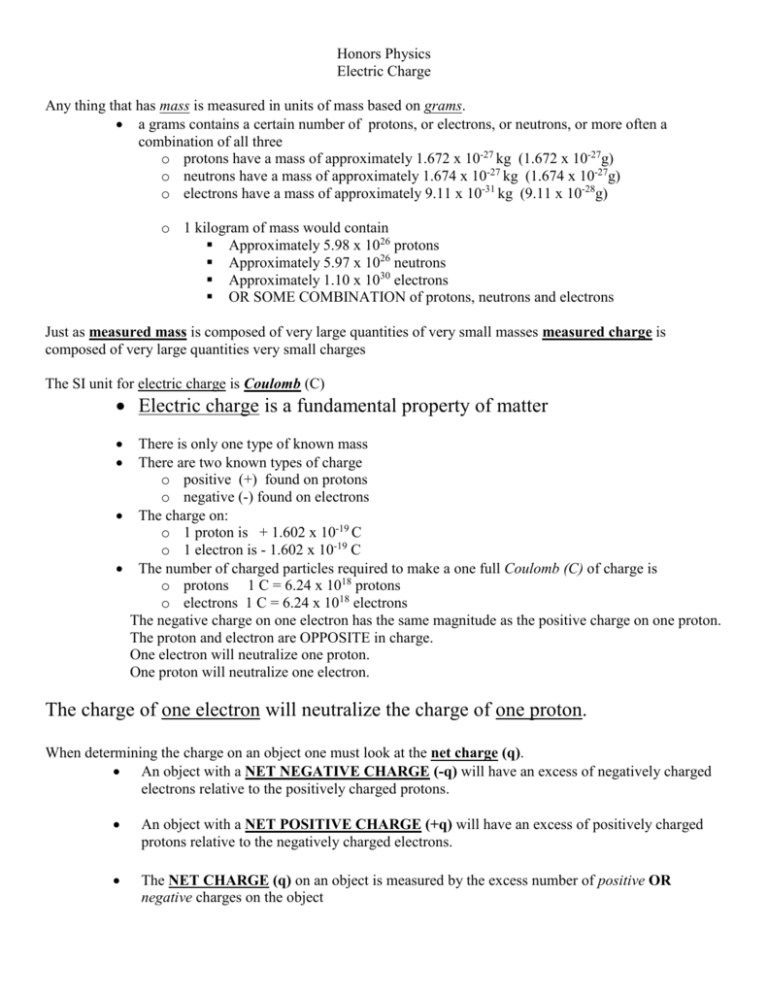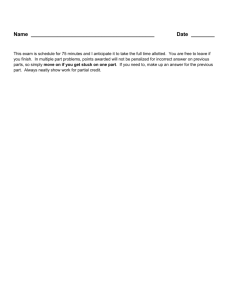one electron - WordPress.com
advertisement

Honors Physics Electric Charge Any thing that has mass is measured in units of mass based on grams. a grams contains a certain number of protons, or electrons, or neutrons, or more often a combination of all three o protons have a mass of approximately 1.672 x 10-27 kg (1.672 x 10-27g) o neutrons have a mass of approximately 1.674 x 10-27 kg (1.674 x 10-27g) o electrons have a mass of approximately 9.11 x 10-31 kg (9.11 x 10-28g) o 1 kilogram of mass would contain Approximately 5.98 x 1026 protons Approximately 5.97 x 1026 neutrons Approximately 1.10 x 1030 electrons OR SOME COMBINATION of protons, neutrons and electrons Just as measured mass is composed of very large quantities of very small masses measured charge is composed of very large quantities very small charges The SI unit for electric charge is Coulomb (C) Electric charge is a fundamental property of matter There is only one type of known mass There are two known types of charge o positive (+) found on protons o negative (-) found on electrons The charge on: o 1 proton is + 1.602 x 10-19 C o 1 electron is - 1.602 x 10-19 C The number of charged particles required to make a one full Coulomb (C) of charge is o protons 1 C = 6.24 x 1018 protons o electrons 1 C = 6.24 x 1018 electrons The negative charge on one electron has the same magnitude as the positive charge on one proton. The proton and electron are OPPOSITE in charge. One electron will neutralize one proton. One proton will neutralize one electron. The charge of one electron will neutralize the charge of one proton. When determining the charge on an object one must look at the net charge (q). An object with a NET NEGATIVE CHARGE (-q) will have an excess of negatively charged electrons relative to the positively charged protons. An object with a NET POSITIVE CHARGE (+q) will have an excess of positively charged protons relative to the negatively charged electrons. The NET CHARGE (q) on an object is measured by the excess number of positive OR negative charges on the object Negative charges (electrons) are very much easier to add or remove from an object relative to protons, so the charge on an object is most often determined by the transfer of electrons from one object to another. o The object that losses electrons becomes positively charged. o The object that gains electrons becomes negatively charged. EQUATION FOR NET CHARGE (q) q = ± ne- ± refers to the excess of, or lack of electrons. n = number of excessive electrons, or lack of electrons* e- = charge of a single electron -1.602 x 10-19C * lack of electrons = number of excess protons LAW OF CONSERVATION OF CHARGES The NET CHARGE of a closed system remains constant Examples 1) You are shuffling across a carpeted floor and you acquire an excess of electrons due to the charging by friction. The number of excess electrons is 3.5 x 1010. a. Will you have a positive or negative net charge? b. What is the size of the net charge? Answer a. Negative net charge because you have gained an excess of negatively charged electrons. b. q = ± neq = + (3.5 x 1010) (-1.602 x 10-19C ) q = -5.6 x 10-9C q = -5.6nC nC = nano Coulombs 2) An electrically neutral metal sphere touches a second metal sphere. The 1st sphere losses 7.8 x 108 electrons while in contact with the second sphere. a. Does the 1st sphere have a positive or negative net charge after the contact? b. What is the size of the net charge on the 1st sphere after the contact? c. What is the gain in charge on the 2nd metal sphere? Answers a. Positive net charge because it lost electrons. The 1st sphere was originally electrically neutral and it lost electrons, now it has more protons than electrons b. q = ± neq = - (7.8 x 108) (-1.602 x 10-19C ) q = + 1.25 x 10-10C q = +1.25nC c. q = ± neq = +(7.8 x 108) (-1.602 x 10-19C ) q = - 1.25 x 10-10C q = - 1.25nC





